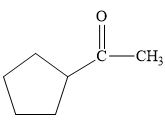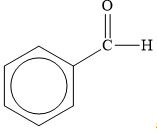
Chemistry for Today: General Organic and Biochemistry
9th Edition
ISBN: 9781337514576
Author: Seager
Publisher: Cengage
expand_more
expand_more
format_list_bulleted
Textbook Question
Chapter 14, Problem 14.18E
Use a dotted line to show hydrogen bonding between molecules in each of the following pairs:
a.  and
and 
b.  and
and 
Expert Solution & Answer
Want to see the full answer?
Check out a sample textbook solution
Students have asked these similar questions
Complete the following table. The only density needed is already given. Show your
calculations in a neat and easy-to-follow manner in the space below the table. All units
should be included and significant figures should be given close attention. Be sure to notice
that the amount of material should be in millimoles rather than moles, and the theoretical
mass of the product should in milligrams rather than grams.
LOCH 3
+
H2SO4
HNO 3
O=C-OCH 3
NO2
x
H₂O
F.W.
4.0 mL 1.3 M
amount
0.50 mL
in H2SO4
mg Theoretical
Theoretical
mmoles
density
1.09
Kumada Coupling:
1. m-Diisobutylbenzene below could hypothetically be synthesized by Friedel-Crafts reaction. Write out the reaction with a
mechanism and give two reasons why you would NOT get the desired product.
Draw the reaction (NOT a mechanism) for a Kumada coupling to produce the molecule above from m-dichlorobenzene.
Calculate the theoretical yield for the reaction in question 2 using 1.5 g of p-dichlorobenzene and 3.0 mL isobutyl bromide.
What signals appeared/disappeared/shifted that indicate that you have your intended product and not starting material? What
other impurities are present in your product and how do you know?
Wintergreen from Aspirin:
1. In isolating the salicylic acid, why is it important to press out as much of the water as possible?
2. Write the mechanism of the esterification reaction you did.
3.
What characteristic absorption band changes would you expect in the IR spectrum on going from aspirin to salicyclic acid and
then to methyl salicylate as you did in the experiment today? Give approximate wavenumbers associated with each functional
group change.
What signals appeared/disappeared/shifted that indicate that you have your intended product and not starting material? What
other impurities are present in your product and how do you know?
Chapter 14 Solutions
Chemistry for Today: General Organic and Biochemistry
Ch. 14 - Prob. 14.1ECh. 14 - Prob. 14.2ECh. 14 - Identify each of the following compounds as an...Ch. 14 - Identify each of the following compounds as an...Ch. 14 - Prob. 14.5ECh. 14 - Prob. 14.6ECh. 14 - Prob. 14.7ECh. 14 - Prob. 14.8ECh. 14 - Draw structural formulas and give IUPAC names for...Ch. 14 - Draw structural formulas and give IUPAC names for...
Ch. 14 - Each of the following names is wrong. Give the...Ch. 14 - Each of the following names is wrong. Give the...Ch. 14 - Prob. 14.13ECh. 14 - Prob. 14.14ECh. 14 - Prob. 14.15ECh. 14 - Explain why propane boils at 42C, whereas ethanal,...Ch. 14 - Use a dotted line to show hydrogen bonding between...Ch. 14 - Use a dotted line to show hydrogen bonding between...Ch. 14 - Prob. 14.19ECh. 14 - Prob. 14.20ECh. 14 - Prob. 14.21ECh. 14 - Prob. 14.22ECh. 14 - Prob. 14.23ECh. 14 - Prob. 14.24ECh. 14 - Label each of the following as acetals, ketals, or...Ch. 14 - Label each of the following as acetals, ketals, or...Ch. 14 - Label each of the following structures as a cyclic...Ch. 14 - Label each of the following structures as a...Ch. 14 - What two functional groups react to form the...Ch. 14 - Hemiacetals are sometimes referred to as potential...Ch. 14 - Complete the following statements: a. Oxidation of...Ch. 14 - Prob. 14.32ECh. 14 - Prob. 14.33ECh. 14 - Prob. 14.34ECh. 14 - Prob. 14.35ECh. 14 - Not all aldehyde give a positve Bendicts test....Ch. 14 - A stockroom assistant prepares three bottles, each...Ch. 14 - Glucose, the sugar present within the blood, gives...Ch. 14 - Fructose, present with glucose in honey, reacts...Ch. 14 - Prob. 14.40ECh. 14 - Prob. 14.41ECh. 14 - Complete the following equations. If no reaction...Ch. 14 - Complete the following equations. If no reaction...Ch. 14 - Describe the products that result when hydrogen...Ch. 14 - Prob. 14.45ECh. 14 - Draw structural formulas for the products of the...Ch. 14 - The following compounds are cyclic acetals or...Ch. 14 - The following compounds are cyclic acetals or...Ch. 14 - Write equations to show how the following...Ch. 14 - Prob. 14.50ECh. 14 - Identify the most important aldehyde and ketone...Ch. 14 - Using Table 14.3, name an aldehyde or ketone used...Ch. 14 - Prob. 14.53ECh. 14 - CH3COH(O)CH3COOHacetaldehydeaceticacid You need to...Ch. 14 - The addition of water to aldehydes and ketones...Ch. 14 - Prob. 14.56ECh. 14 - Formaldehyde levels above 0.10mg/1000L of ambient...Ch. 14 - In the IUPAC name for the following ketone, it is...Ch. 14 - Why can formaldehyde (CH2O) be prepared in the...Ch. 14 - Other addition reactions of aldehydes occur....Ch. 14 - Prob. 14.61ECh. 14 - Prob. 14.62ECh. 14 - Vanilla flavoring is either extracted from a...Ch. 14 - Prob. 14.64ECh. 14 - The use of acetone in laboratory experiments must...Ch. 14 - Prob. 14.66ECh. 14 - Prob. 14.67ECh. 14 - Which of the following would be classified as a...
Knowledge Booster
Learn more about
Need a deep-dive on the concept behind this application? Look no further. Learn more about this topic, chemistry and related others by exploring similar questions and additional content below.Similar questions
- Synthesis of ZybanⓇ: 1. Write a mechanism for the bromination of m-chloropropiophenone. Br₂ CH2Cl2 Cl Br 2. Give the expected m/z (to a round number) for the molecular ion from the product above (including isotopic peaks). 3. What signals appeared/disappeared/shifted that indicate that you have your intended product and not starting material? What other impurities are present in your product and how do you know?arrow_forwardSynthesis of Ibuprofen-Part 2: 1. Some pain relievers including ibuprofen (MotrinⓇ) and naproxen (Aleve®) are "α-arylpropanoic acids." Look up the structure of naproxen (AleveⓇ), another a-arylpropionic acid. Using the same reactions that we used for making ibuprofen, show how to make naproxen from the compound below. Show all intermediates and reagents in your synthesis. Show how you would prepare ibuprofen starting from p-isobutylbenzene rather than p-isobutylacetophenenone. What reaction steps would need to change/add? 3. What signals appeared/disappeared/shifted that indicate that you have your intended product and not starting material? What other impurities are present in your product and how do you know?arrow_forwardAcid Catalyzed Aromatization of Carvone: 1. Starting with the ketone, below, draw a mechanism for the reaction to give the phenol as shown. H2SO4 HO- H₂O 2. Why do we use CDCl instead of CHCl, for acquiring our NMR spectra? 3. Why does it not matter which enantiomer of carvone is used for this reaction? What signals appeared/disappeared/shifted that indicate that you have your intended product and not starting material? What other impurities are present in your product and how do you know?arrow_forward
- Assign this H NMRarrow_forwardPlease complete these blanks need that asaparrow_forwardNitration of Methyl Benzoate: 1. Predict the major product for the reaction below AND provide a mechanism. Include ALL resonance structures for the intermediate. C(CH3)3 NO₂* ? 2. Assuming the stoichiometry is 1:1 for the reaction above, what volume of concentrated nitric acid would be required to mononitrate 0.50 grams of the compound above? What product(s) might you expect if you nitrated phenol instead of methyl benzoate? Explain your reasoning. What signals appeared/disappeared/shifted that indicate that you have your intended product and not starting material? What other impurities are present in your product and how do you know?arrow_forward
- Sodium Borohydride Reduction (continued on the next page): 1. Draw the product of each of the reactions below and give the formula mass to the nearest whole number. ? (1) NaBH (2) acid (1) NaBD4 (2) acid ? 2. In mass spectra, alcohols typically break as shown in equation 8 in chapter 11 (refer to your lab manual). The larger group is generally lost and this gives rise to the base peak in the mass spectrum. For the products of each of the reactions in question # 1, draw the ion corresponding to the base peak for that product and give its mass to charge ratio (m/z). 3. Given the reaction below, calculate how many mg of 1-phenyl-1-butanol that can be produced using 31 mg NaBH4 and an excess of butyrophenone. 4. + NaBH4 OH (after workup with dilute HCI) What signals appeared/disappeared/shifted that indicate that you have your intended product and not starting material? What other impurities are present in your product and how do you know?arrow_forwardAspirin from Wintergreen: 1. In isolating the salicylic acid, why is it important to press out as much of the water as possible? Write a step-by-step mechanism for the esterification of salicylic acid with acetic anhydride catalyzed by concentrated H₂SO4. 3. Calculate the exact monoisotopic mass of aspirin showing your work. What signals appeared/disappeared/shifted that indicate that you have your intended product and not starting material? What other impurities are present in your product and how do you know?arrow_forwardSynthesis of Ibuprofen-Part 1: 1. What characteristic absorption band changes would you expect in the IR spectrum on going from p-isobutylacetophenone to 1-(4-isobutylphenyl)-ethanol and then to 1-(4-isobutylphenyl)-1-choroethane as you did in the experiment today? Give approximate wavenumbers associated with each functional group change. Given that the mechanism of the chlorination reaction today involves formation of a benzylic carbocation, explain why the following rearranged product is not formed. محرم محمد 3. Why do we use dilute HCl for the first step of the reaction today and concentrated HCI for the second step? What signals appeared/disappeared/shifted that indicate that you have your intended product and not starting material? What other impurities are present in your product and how do you know?arrow_forward
arrow_back_ios
SEE MORE QUESTIONS
arrow_forward_ios
Recommended textbooks for you
 Chemistry for Today: General, Organic, and Bioche...ChemistryISBN:9781305960060Author:Spencer L. Seager, Michael R. Slabaugh, Maren S. HansenPublisher:Cengage Learning
Chemistry for Today: General, Organic, and Bioche...ChemistryISBN:9781305960060Author:Spencer L. Seager, Michael R. Slabaugh, Maren S. HansenPublisher:Cengage Learning General, Organic, and Biological ChemistryChemistryISBN:9781285853918Author:H. Stephen StokerPublisher:Cengage Learning
General, Organic, and Biological ChemistryChemistryISBN:9781285853918Author:H. Stephen StokerPublisher:Cengage Learning Organic And Biological ChemistryChemistryISBN:9781305081079Author:STOKER, H. Stephen (howard Stephen)Publisher:Cengage Learning,
Organic And Biological ChemistryChemistryISBN:9781305081079Author:STOKER, H. Stephen (howard Stephen)Publisher:Cengage Learning,
 Chemistry: Matter and ChangeChemistryISBN:9780078746376Author:Dinah Zike, Laurel Dingrando, Nicholas Hainen, Cheryl WistromPublisher:Glencoe/McGraw-Hill School Pub Co
Chemistry: Matter and ChangeChemistryISBN:9780078746376Author:Dinah Zike, Laurel Dingrando, Nicholas Hainen, Cheryl WistromPublisher:Glencoe/McGraw-Hill School Pub Co

Chemistry for Today: General, Organic, and Bioche...
Chemistry
ISBN:9781305960060
Author:Spencer L. Seager, Michael R. Slabaugh, Maren S. Hansen
Publisher:Cengage Learning

General, Organic, and Biological Chemistry
Chemistry
ISBN:9781285853918
Author:H. Stephen Stoker
Publisher:Cengage Learning

Organic And Biological Chemistry
Chemistry
ISBN:9781305081079
Author:STOKER, H. Stephen (howard Stephen)
Publisher:Cengage Learning,



Chemistry: Matter and Change
Chemistry
ISBN:9780078746376
Author:Dinah Zike, Laurel Dingrando, Nicholas Hainen, Cheryl Wistrom
Publisher:Glencoe/McGraw-Hill School Pub Co
07 Physical Properties of Organic Compounds; Author: Mindset;https://www.youtube.com/watch?v=UjlSgwq4w6U;License: Standard YouTube License, CC-BY